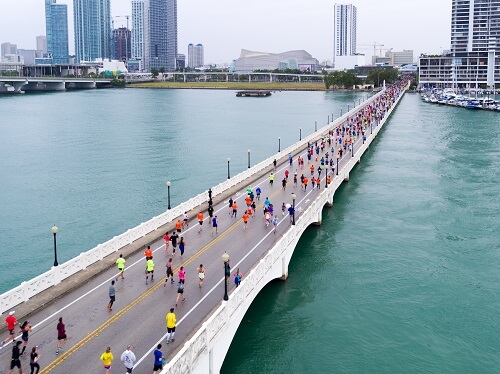Welcome to RACE WEEK! Make sure you know the ins and outs of race…
Fit for 2 – Exercising While Pregnant
We have all heard the stories, passed down from generations, of our sisters of old bearing children through everything from surviving the Ice Age and global epidemics, to colonization and traveling to new lands, to widespread industrialization and the chaotic modern career. Let’s face it, women are pretty resilient. We understand, as with all things pregnancy, there are risks to placing exertion on growing life. Yet, pregnant women crossed the Wild West and spent weeks in jail for protesting for our right to vote (We see you, Emmeline Pankhurst.) So, why is there a remaining stigma behind the contemporary fit and pregnant lifestyle?
The truth of the matter boils down to ill-informed word of mouth, misconceptions and outdated guidelines. There seems to have always been a dichotomy between what should or should not be done while carrying a child. “Pregnant women were traditionally told ‘don’t move’ and ‘eat for two,’” says Raul Artal, MD, chairman of the Department of Obstetrics, Gynecology and Women’s Health at the St. Louis University School of Medicine.
Many myths and misconceptions about what is good and healthy for women and their unborn children has traditionally replaced information with fear: “There’s been a lot of fear, and that’s really been a disservice,” says Catherine Cram, MS, an exercise physiologist and coauthor with Tere Stouffer Drenth of Fit Pregnancy for Dummies (Wiley Publishing, 2004). Stories passed down from nosy neighbors to frantic, expectant mothers has perpetuated this cycle for years. Lack of accessible information coupled with archaic medicinal practices led to many misconceptions which has carried over into the late 20th century.
Fast forwarding to the 1980’s, one forward thinking gentleman would embark on a journey whose repercussions would be analyzed and postulated to this day. James Clapp III, MD set out to study what he assumed would be the health risks associated with exercising during pregnancy. With his research and work some of the following misconceptions were put to rest:
- “Exercise can cause infertility, low birth weight, congenital abnormalities and preterm labor.”
- “Running and other forms of weight-bearing exercise can cause miscarriage.”
- “Don’t exercise for more than 15 minutes at a time.”
- “Don’t start a new exercise regimen once you become pregnant.”
His work revolutionized the modern woman in a decade that was all about fitness (We see you Jane Fonda) and helped spread the word on a topic that has been, up until then, kept mum (pun intended).
With these misconceptions being put to rest, why do we continue to hear opposing advice from professionals? “Although the American College of Obstetricians and Gynecologists (ACOG) updated its guidelines in 2002, lifting most restrictions on exercise during pregnancy (including keeping your heart rate under 140), many healthcare providers still aren’t aware of the revisions” states Sheila Mulrooney Eldred for the Experience Life Magazine article, Fitness for 2.
While more information becomes readily available, thanks to that other revolution of the 80’s (hello internet), we can now dive into all the benefits that come from exercising while pregnant. According to Clapp’s studies, which can be found in his book Exercising Through Your Pregnancy, there is a plethora of benefits to exercising while pregnant such as:
- 50 percent less likely to need induced labor or to require Pitocin (synthetic oxytocin)
- 50 percent less likely to need intervention because of abnormalities in the fetal heart rate
- 75 percent less likely to need forceps or a cesarean section
Not to mention that these women tend to feel better about themselves during and after the pregnancy. In addition, Eldred continues: “Clapp discovered that the placentas of fit moms tend to function better, creating a better blood flow between mother and fetus. Exercising also increases blood volume in moms, preventing varicose veins and swelling.”
Now that you have the green light, what now? We are not suggesting that you enroll in Extreme CrossFit with spiked boulders (please don’t), but you do have options on various exercise regimes from running to swimming in order to keep you active and fit while carrying your little bun in the oven. Release the fear of the past and embrace the possibility of the future. Eldred notes these following general guidelines:
- Fuel up. Eat enough to satiate hunger, Clapp says – preferably in small, frequent meals balanced with proteins, complex carbohydrates and healthy fats, and preferably from whole-food sources.
- Stay hydrated. Drink enough to keep your urine relatively clear (that’ll require approximately 91 ounces a day).
- Be gentle with yourself. Expect to ease up here and there. Pregnancy, after all, will cause more dramatic changes in your body in a short period of time than anything else in your life. Your body is also putting a lot of energy and resources into making another body – not a trifling effort!
- Rest as much as possible. Clapp suggests spending an extra hour at leisure for each hour you work out (in addition to your regular rest), and avoiding exercising to the point that you feel stressed out about it.
- Adjust your athletic expectations. Regardless of your activity or fitness proficiency, it’s important to monitor the intensity of your exertion.
Pregnancy is a beautiful and cherished moment in a woman’s life. “I like to see women trusting their own bodies, and that’s what I generally advise them to do. There’s no reason to let everyone around you make you feel tentative about this really wonderful experience.” says Cram when asked for his best advice. While there are some changes that are forced upon us (until next time, alcohol….hello maternity clothes), exercise shouldn’t be one of them.
For the full article, please visit Experience Life, Fitness for 2 (Eldred, 2005).



